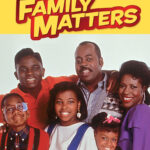For over a decade, Modern Family (2009) has been a staple in households, offering a comedic lens into the complexities of family life. Having followed the series and explored its themes in media studies, it’s clear the show provides a rich case study on the portrayal of gay characters, specifically Mitchell Pritchett and Cameron Tucker, often referred to as “Cam,” and how they both subvert and reinforce traditional gay stereotypes. While Modern Family encompasses a diverse cast navigating various life stages and identities, this analysis will concentrate on Cam and Mitch, examining their impact on LGBTQ+ representation in mainstream media.
Challenging Gay Stereotypes: Commitment and Family
Created by Christopher Lloyd and Steven Levitan, Modern Family, airing on ABC, immediately distinguished itself by showcasing an “untraditional” family structure. At its core is Jay Pritchett, the family patriarch, and branching out are his children, Claire and Mitchell, his wife Gloria, and stepson Manny. Claire is married to Phil Dunphy, and they raise their three children, Haley, Alex, and Luke. Crucially, the series begins with Mitchell (Mitch) Pritchett and Cameron (Cam) Tucker already in a committed five-year relationship and having just adopted their daughter, Lily. This deliberate starting point is significant. From the outset, Modern Family presents Cam and Mitch not as individuals exploring their identities, but as a fully formed couple deeply invested in family life.
This immediately challenges the pervasive stereotype of gay men as promiscuous and incapable of long-term commitment. Media scholar Rodriguez (2017) notes how traditional representations often depict gay men as “unmarried with an unsatisfiable sexual appetite.” Modern Family actively counters this narrative by showcasing Cam and Mitch’s enduring loyalty and commitment to each other. The show’s creators made a conscious decision to introduce them as a stable unit, bypassing the typical storyline of “coming out” or the initial stages of a gay relationship. This normalization is powerful, especially for audiences who rely on media portrayals to understand societal norms and acceptance.
When viewers witness the success and normalcy of Cam and Mitch’s relationship, especially in comparison to portrayals of hyper-sexualized or unstable gay characters in other shows, it offers a vital counter-narrative. It emphasizes that commitment and family are central to their happiness, directly challenging stereotypical depictions. Cam and Mitch’s relationship, therefore, acts as a significant and positive divergence from established gay stereotypes in media.
Further dismantling stereotypes is their decision to adopt Lily, a Vietnamese baby. As a gay couple choosing to raise a child without a mother figure, they directly confront societal heteronormativity and open themselves to potential prejudice. Sociologist Brian Powell (Pappas, 2012) highlights that any challenges faced by children of same-sex parents stem not from the parents’ gender, but from societal bias. Modern Family addresses this head-on. In the pilot episode, Mitch confronts a woman who makes a seemingly derogatory comment about them being “creme puffs” while holding Lily. Mitch immediately steps into a protective paternal role, demonstrating courage and a willingness to defend his family (ABC). While the comment turns out to be about actual cream puffs, the scene underscores the inherent paternal instincts and protective nature of both Cam and Mitch. This moment, even played for humor, illustrates the fluidity of homosexual parents in embodying both traditionally “maternal” and “paternal” roles. Lily’s racial identity, different from her fathers’, further complicates and enriches this portrayal of a modern, untraditional family. Throughout the series, Cam and Mitch navigate parenting with shared responsibility and love, showcasing a diverse and nuanced representation of gay parenthood in mainstream media, moving beyond simplistic or boxed-in portrayals.
Reaffirming Stereotypes: Lifestyle and Audience Comfort
However, while Cam and Mitch break down certain barriers, their characters also inadvertently reinforce other, more subtle gay stereotypes. As Ross (2014) points out, media representations of gay characters often fall into the mold of “‘white, affluent, trend-setting, Perrier-drinking, frequent-flyer using, Ph.D.-holding consumer citizens with more income to spend than they know what to do with.’” This stereotype, while seemingly positive on the surface, can be limiting and exclusionary.
Modern Family subtly plays into this. Cam, in particular, embodies aspects of this affluent, lifestyle-focused stereotype. His flamboyant personality, love for the dramatic, and refined tastes, while contributing to his comedic charm, align with certain preconceived notions about gay men. The show itself acknowledges this at times, often through jokes about their “lifestyle.” Their manner of dress, their sophisticated demeanor, and their engagement in certain cultural activities sometimes subtly reaffirm this “white, affluent” stereotype.
Considering Modern Family airs on ABC, a network historically associated with family-oriented and, at times, traditionally-minded programming, this approach appears to be a calculated decision. Introducing gay characters who, while gay, also fit into pre-existing, palatable stereotypes might have been perceived as a “safer” strategy to gain wider audience acceptance. In the context of mass media and societal norms at the time of the show’s premiere, LGBTQ+ representation was still a relatively nascent and sometimes controversial topic in mainstream television. LGBTQ+ characters were often relegated to the margins or “othered” in contemporary film and TV (Ross, 2014).
Therefore, the way Cam and Mitch are presented – while progressive in some aspects – also feels somewhat constrained by the need to appeal to a broader, potentially more traditional audience. While their committed relationship and adoption challenge norms, their character traits sometimes reinforce existing stereotypes, possibly as a trade-off for wider acceptance. This approach, while bringing LGBTQ+ representation to a mainstream audience, may inadvertently neglect or alienate younger viewers who fear that being gay necessitates fitting into these pre-defined character descriptors. The Pritchett family’s eventual acceptance of Cam and Mitch, although initially hesitant from Jay, reinforces a narrative of a “(white) modern family” embracing diversity within a specific framework. Had the show explored a more diverse family dynamic, perhaps with an interracial gay couple or characters who defied the affluent stereotype, it might have resonated more profoundly with viewers grappling with intersectional identities, even if it risked alienating a segment of ABC’s “traditional” audience.
Conclusion: A Modern Family, Progress with Limitations
Does Modern Family truly reinvent the concept of a modern family? The answer is nuanced. The show undeniably advances gay representation and dismantles certain harmful stereotypes, bringing LGBTQ+ issues into mainstream comedic television. However, these advancements are not without limitations. The portrayal of Cam and Mitch, while groundbreaking in some ways, also operates within the confines of audience expectations and network sensitivities. Ultimately, Modern Family successfully sheds light on LGBTQ+ lives and relationships in an accessible and entertaining format, contributing to a broader cultural conversation, even while navigating the complexities of representation and the constraints of mainstream media.
References
ABC. (n.d.). Modern Family: Pilot – Watch Season 1 Episode 01. Retrieved April 09, 2017, from http://abc.go.com/shows/modern-family/episode-guide/season-01/101-pilot
Pappas, S. (2012, January 16). Gay Parents Better Than Straight Parents? What Research Says. Retrieved April 09, 2017, from http://www.huffingtonpost.com/2012/01/16/gay-parents-better-than-straights_n_1208659.html
Rodriguez, N. (Ph. D). Queer Media Analysis. Lecture. March 22, 2017.
Ross, K. (2014). The handbook of gender, sex, and media. Chichester: Wiley Blackwell


